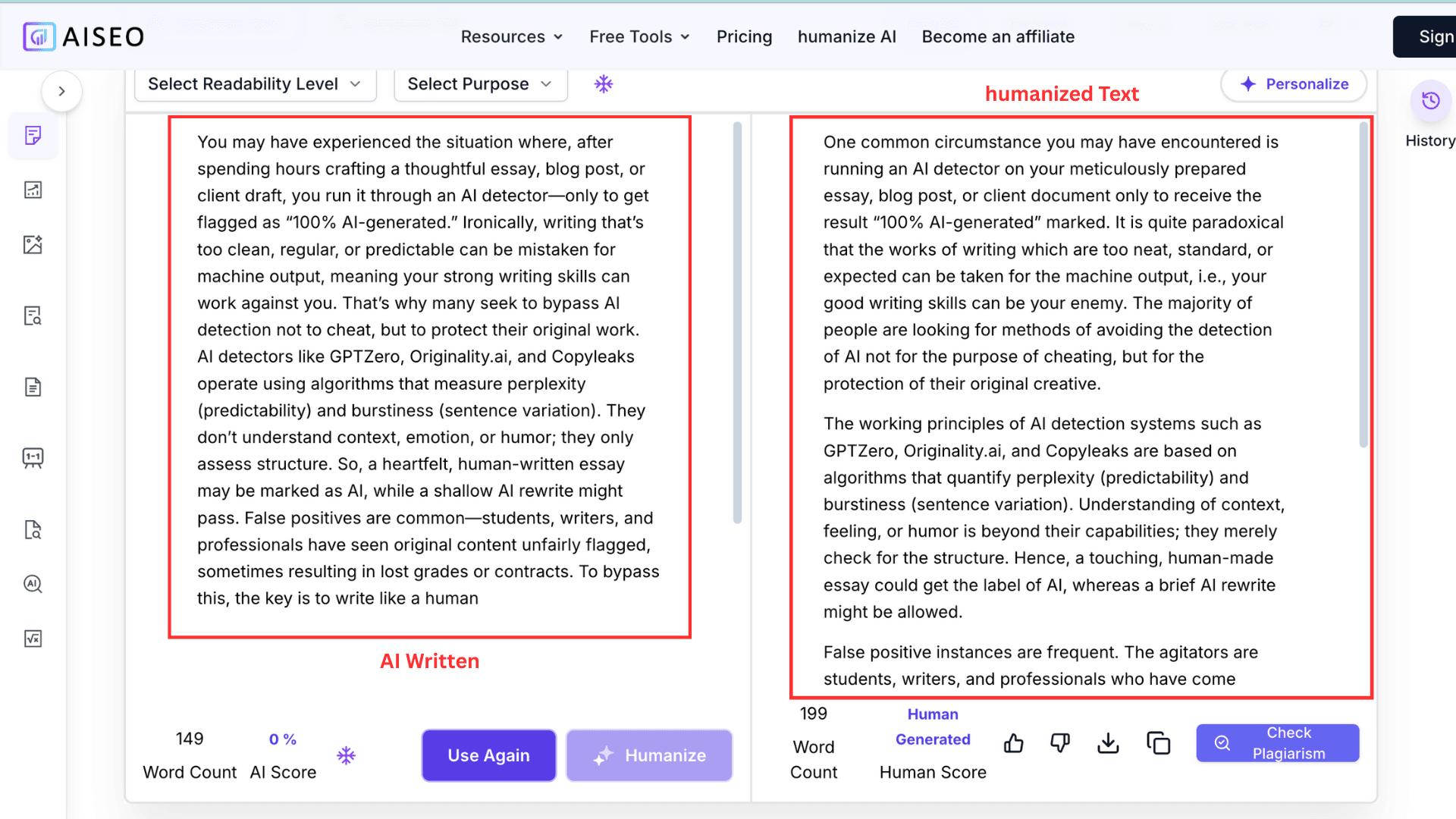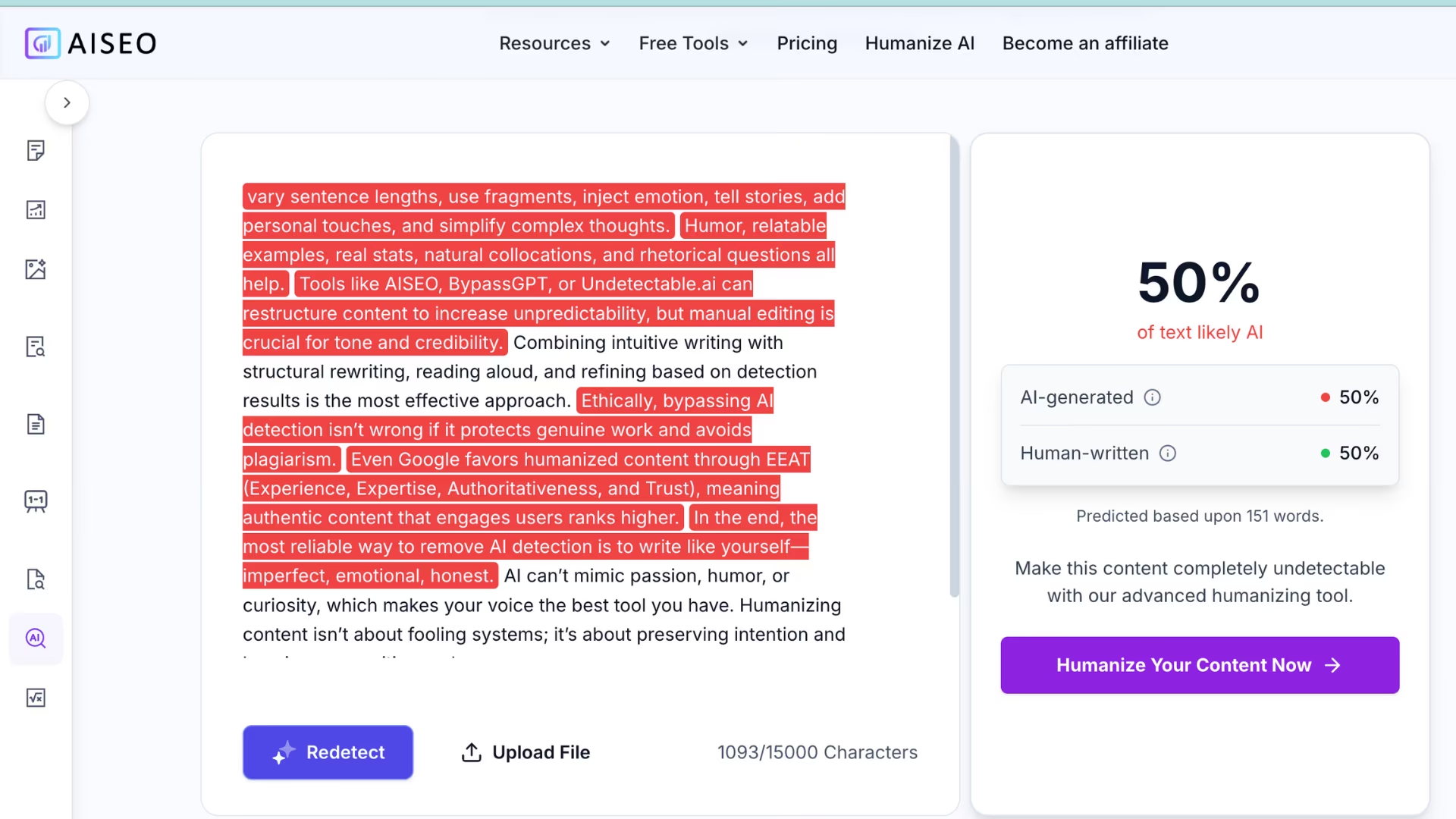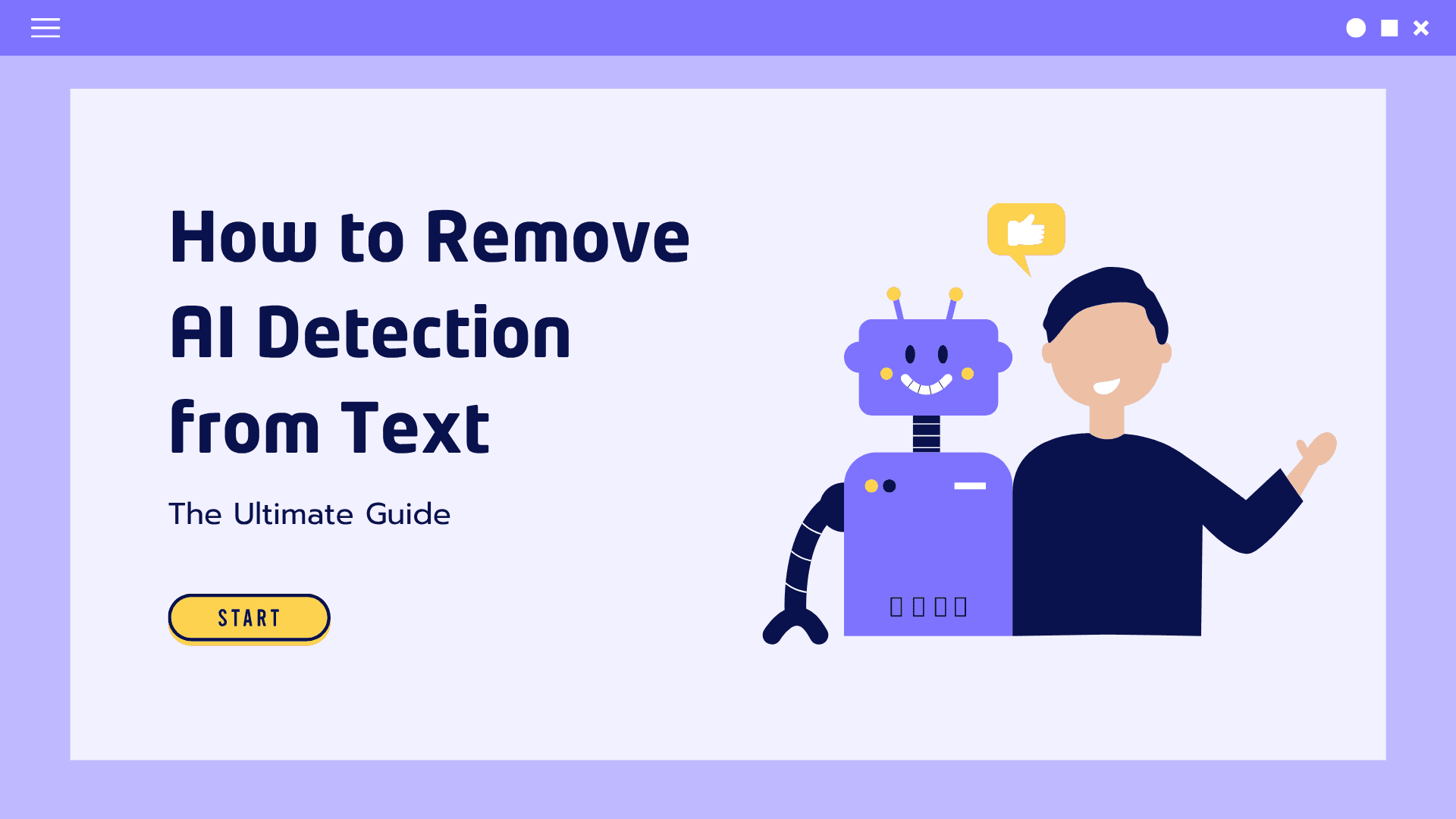You may have experienced the situation once or twice. You go through hours creating a very thoughtful piece of writing — an essay, blog post, or client draft — and then, just to be sure, you run it through an AI detector. Your screen gets the message “100% AI-generated” within a second or two.
One of the reasons why an AI detector may incorrectly flagged a genuine piece of writing is that the writing may sound too neat, too regular, or too "predictable". So, the skill you have can be a disadvantage. That's the reason why people are looking for ways to bypass the AI detection not for cheating purposes but for the protection of their works.
This manual is your complete walk-through of everything — from the working principle of the AI detectors to 10+ authentic strategies that make your writing completely undetectable. You will become familiar with all the methods to make your content more human-like, natural, and emotionally engaging — quality and truth maintained.
Why AI Detection Exists (and Why It’s So Flawed)
AI content detection tools have been designed for an excellent purpose: to identify human-written text from machine-generated text. However, the fact that they are excellent doesn't make them accurate.
Detectors like GPTZero, Originality.ai, and Copyleaks state that they "are authenticity measurers," which is done by the employment of algorithms that comprehend two things — perplexity and burstiness.
- Perplexity measures predictability. If the text of a user contains very simple words and clean grammar, the AI detector thinks, "This looks machine-written."
- Burstiness accounts for the variation between the text length and the number of sentences. Humans naturally mix short and long sentences, make small mistakes, and change the mood of a conversation. AI is usually to be found in a smooth, balanced structure that is the digital counterpart of a monotone voice.
The more grammatically perfect and structured your writing is, ironically, the more "AI" it points out.

This is not only a problem with the algorithm — it is also an empathy gap. Detectors do not understand context, humor, or emotion. They evaluate structure, not essence. That is why your essay with touching analogies can still be marked as AI-generated, while a shallow paraphrased paragraph can get a good score.
Therefore, before you get scared, keep in mind that the detector is not the one who is smarter; it is just programmed differently.
The Real-World Problem: When Human Text Fails AI Tests
If you have ever been identified as a false positive, you should know that you are not the only one. Different kinds of people, like writers, students, journalists, and even professors, have had made-up work signposting “AI-generated”.
According to a Reddit user, a college essay of his which was completely handwritten was given a zero mark because GPTZero rated the essay as AI-produced. Also, a content creator stated that he lost a freelance contract after a plagiarism checker at his client’s place mistakenly labeled his SEO blog as “partially AI.”

That’s the reason why figuring out how to disable AI detection in text isn’t just a clever way to do it — it’s a way to protect your honesty.
What makes the difference is recognizing what “looking human” to the algorithms means — and purposely bringing those signs back to your writing.
How AI Detectors Think (And How to Outsmart Them Naturally)
Artificial intelligence (AI) detectors do not “see” like humans; they are on the lookout for patterns.
Imagine two readers analyzing the same paragraph:
- A human would likely sense the mood, humor, and that the text is understandable.
- An artificial intelligence would look at aspects such as punctuation, the flow, and sentence similarity.
If a piece is too “uniform,” it will give off a vibe that there might be a sneaky side. Yet, if it has imperfections, feelings, or even unexpected shifts of thought – it is re-humanized.
Think of it in this way: You are not fooling a detector. Rather, you are telling it that your writing is living and feeling.
Rewriting with Rhythm: The Power of Human Flow
AI generates text similar to this:
One of the main features of human interaction that is affected by cultural diversity is the very behavior of people, which is essential to consider socializing geography impact."
On the other hand, a human would express it like this:
Travel halfway around the globe, and suddenly, a handshake is transformed into a hug. Besides shaping maps, geography is what determines how people connect.
Do you notice the distinction? The latter is more lively. It mixes shorter and longer sentences. It keeps the reader from becoming disengaged.
For getting more rhythmic-text, you may:
- Deliberately vary your sentence length.
- Include a couple of very short sentences or fragments.
- Imitate speech by using commas where you normally would pause.
- Try conjunctions like and, but, or so at the beginning of the sentence.
Add Emotion, Imperfection, and Honesty
AI detectors can't really grasp the emotional side of the text. When you share emotions like disgust, surprise, or amusement, your voice becomes less recognizable and unpredictability is the main feature of human authenticity.
For example, instead of declaring 'This method produces efficient results,' you might reframe it as 'This trick actually surprised me - it worked better than I thought it would.'
These tiny things help to mix human fingerprints into your work. In your writing, you may find the following helpful:
- Put exclamations, but do it infrequently and be honest (“ Honestly, that's crazy.”)
- Adopt a story-like style ("You know that moment when...")
- Incorporate opinion words ("I admit," "let's be real," "the fact is").
If you want to be more convincing, you should not appear perfect. The use of perfect grammar and symmetry will make you seem like a machine.
Get Specific: Add Details, Examples, and Personal Touches
AI is fond of generalization. People are more dependent on detailed descriptions. When you incorporate details - sensory language, examples or actual situations - the detectors seem to relax.
For example:
Many people enjoy coffee in the morning.” is typical of AI-generated text. “Most people can’t even think straight until that first sip of bitter espresso hits — admit it, you too.” sounds like a human.
Do you see how detail creates a scene rather than a description? Try to add:
- True figures (“Over 60% of marketers now use AI tools daily.”)
- Personal views (“You may have noticed…” or “If you have ever felt…”)
- References to pop culture or real life (“Even Google knows when you sound robotic.”)
Specificity = humanity.
Simplify the Complex — Speak Like You, Not Like a Textbook
Massively stuffed with overdone structure is one of the most glaring signs an AI text has created. Machine authors often combine a multitude of lengthy, complicated, scholarly-style sentences since they are extensively trained on formal data sets. Yet, one should note that humans do not talk as if they were writing essays.
Instead of writing:
AI humanization tools effectively leverage linguistic reconfiguration to bypass algorithmic text classification systems.
Say:
Humanizer tools basically rewrite your text so AI checkers can’t tell it came from a machine.
Such a level of intelligence can be retained and, at the same time, the text does not lose its relatability factor. It is like walking the tightrope between impressing the AI detectors and making your smart friend comfortable with your style — which is precisely that balance.
Master the Art of Sentence Variety
If all your sentences start the same — subject, verb, object — detectors scream “AI.” Humans use rhythm variety subconsciously.
Examples:
- Start with when or as (“When you first read it, it sounds robotic.”)
- Use fragments for emphasis (“A pause. A thought. A change.”)
- Ask rhetorical questions (“You’ve noticed that, right?”)
The trick is to sound conversational without losing professionalism. Think like a podcast host, not a robot professor.
Use Collocations and Natural Word Pairings
One of the typical errors that AI makes is the use of collocations incorrectly. It may provide as an instance the term "powerful rain" or "large happiness". People would say "heavy rain" or "great joy".
Such subtle signals have an influence. After the final check, reading the text aloud is very important. If a certain phrase gives a feeling of being not quite right, then it is necessary to correct it. The aim is not to have perfect grammar but rather to sound natural.
Humanize Through Humor and Relatability
Humor is one of the hardest things for AI to replicate. It requires context, timing, and shared understanding — all very human traits.
Even a light touch of humor can break AI monotony:
I tried explaining ChatGPT to my aunt, and five minutes later, we were talking about her cat.
It’s not a punchline — it’s a connection point. Humor humanizes because it reveals perspective. Detectors can’t quantify laughter, and that’s your advantage.
Add Real Data, Sources, or Quotes
AI detectors can’t verify or validate information.Adding a real statistic, named source, or credible citation instantly lowers AI probability scores.
Example:
According to the Content Authenticity Initiative, 32% of flagged AI content is actually human-written.
When you include specific references, your content appears research-based — something AI detectors associate with human effort and credibility.
When to Use Tools That Remove AI Detection
If you’re working with large volumes of text or need instant results, consider AI-humanizing tools that specialize in structural rewriting rather than word substitution. These are not paraphrases — they mimic human unpredictability.
Here are some that perform well in 2025 tests:
- Humanize AI Text Tool (AISEO.ai): Advanced semantic rewriting that maintains meaning and tone.
- BypassGPT: Known for bypassing Originality.ai, GPTZero, and Content at Scale effectively.
- Undetectable.ai: Focuses on sentence-level reconstruction to maintain flow and originality.
These tools reformat sentence patterns, inject unpredictability, and improve burstiness — all while keeping your message intact.
But here’s the golden rule: always review and edit afterward. The human touch still beats every algorithm.
Combine Manual Edits with Tool Assistance
The best results come from mixing your intuition with AI tools. Here’s an ideal workflow:
Write naturally — use your tone and rhythm.
Run through a humanizer for structural variety.
Read aloud to add emotional flow.
Run it again through an AI detector (GPTZero, Copyleaks, etc.)
Polish manually where flagged.
This hybrid method gives you the best of both worlds: speed and soul.
The Ethics of Bypassing AI Detection
Let’s address the elephant in the room — is bypassing AI detection wrong? It depends on your intent.
If you’re using these strategies to hide copied or plagiarized text — yes, that’s unethical. But if you’re simply protecting genuine work or enhancing AI-assisted drafts, you’re not cheating the system; you’re balancing it.
AI detectors often punish writers unfairly. So learning to bypass them is not deception — it’s self-defense in a tech-biased world.
Use these methods responsibly:
- Always fact-check your AI content.
- Maintain originality and personal insight.
- Never submit AI-written text as your own academic work.
Remember — the goal isn’t to “outsmart robots.” It’s to remind them that creativity still belongs to humans.
Why Search Engines Care About Human Writing
Google is also going to EEAT (Experience, Expertise, Authoritativeness, and Trust) that is to say your content should not only be recognized by AI detectors but it should also have a human vibe.
If your audience keeps time on your page, interacts with your content and shares it, then Google will give you a higher ranking. Hence, the removal of AI detection is actually a SEO booster.
The content of humans are engaging while those of AI are designed to rank. However, one cannot do without the other as human emotion is the only driver of trust and trust is the only driver of rankings.
Final Thought: Write Like a Human, Always
The fundamental principle of the best method for AI detection removal from text is writing like oneself – imperfect, emotional, and unpredictable.
Breaks between ideas. Questioning in the middle of the paragraph. Adding real-world reactions. Even one sigh ("Honestly, that's exhausting.") can alter your tone enough for the detector to fail.
Detectors can't feel passion, humor, or curiosity – and that is your secret weapon. Therefore, do not sound like AI trying to sound human. Sounds like you.
Besides, if you require more assistance, resources such as AISEO come with the attribute of being propelled only to protect the intention of the writer while endowing with the warmth and cadence of genuine human writing.
Truly, authenticity is not only about passing a scan test.
It's about making sure that your words sound like those of a person who cares.
Frequently Asked Questions on How to Remove AI Detection from Text
What is the simplest method to de-AI detection in texts?
The merging of manual rewriting (which is characterized by emotion, rhythm, and details) and AI humanizer tools such as AISEO or BypassGPT. Such a combined process yields the most natural results.
Is it possible to trick AI detectors completely?
A fully rewritten text with some unpredictability can be even with a strict Originality.ai detector be allowed with less than 5% AI probability.
Are humanizing AI-generated text and ethics contradictory?
No, provided you use it for the sake of the reading aid, the authenticity preservation, or fixing of false flag cases. It turns into an unethical practice only when it is used for dissimulation purposes.
Are free AI bypassers effective?
They can contribute to a slight lowering of detection. However, the premium models with advanced semantic rewriting are far more powerful in achieving their goal.
Is AI removal impacting SEO?
Yes, in a positive way. The humanized text is better reading, dwell time is longer, and it is in correlation with Google's EEAT standards that means your overall rankings are improved.

About Dilyar Buzan
Founder & CEO at AISEO
Artificial Intelligence - University of Amsterdam
LLM engineer
